Photocomix are strange creatures. They look like a hybrid of a photography medium and a comics format, and when you spot them in the wild you’re never sure whether they arose as some part of a natural evolutionary process in art or if they were the result of some kind of misguided experiment, maybe even one gone wrong. That reaction’s been shaped by encountering low-quality work with vague pretensions at humor, or perhaps offering some behind the scenes reveals about the comics making process. Frozen, melodramatic poses and cheesy dialogue are par for the course. And so, if a reader spots photocomix roaming free online or in a shop, they approach with caution and refuse to get their hopes up regarding quality.
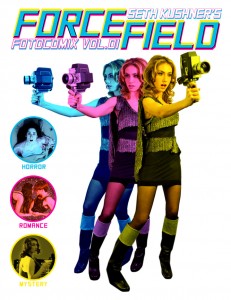
Then there’s FORCEFIELD FOTOCOMIX, which makes you feel guilty for all of that instinctual caution and pre-emptive wariness. It gives you what no one really dares expect or demand from photocomix, a team of seriously talented individuals on a mission to exploit the full potential of the medium. To do this, they decide to spin this collection of comics into a number of genres, covering all the bases and it’s as if they are illustrating future directions for photocomix.
The man behind the camera, someone whose work has defined “serious” photography of the cultural zeitgeist in the past decade and then some, is Seth Kushner, the co-creator of the celebration of comics tradition LEAPING TALL BUILDINGS with Christopher Irving. Kushner’s photo portraits of comics creators in LEAPING TALL BUILDINGS have garnered so much attention that they’ve been scavenged by internet sites repeatedly and Neil Gaiman even chose to use Kushner’s portrait of him as his new dust-jacket image. He’s been working on photocomix for some time now, creating a CulturePOP series for the digital arts salon TRIP CITY, profiling real lives in comics format from author Jonathan Ames to adult film star Stoya, but FORCEFIELD is a departure into the realm of total composition in fictional realities.
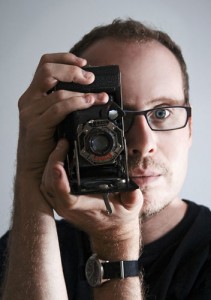
During an informal conversation at Hang Dai Studios, where Kushner keeps a tidy computer work station flanked by a few vinyl and action figures, he revealed some of the process behind his striking cover to FORCE FIELD. He staged a full-on photo-shoot to capture the images in his mind by engaging actress Zoe Sloan, as well as a costume designer and a makeup artist, to create a Barbarella homage fused with a direct design reference to a Jim Steranko cover of BLADE RUNNER from Marvel Comics. The Steranko cover, which uses multiple color reduplications of the hero pointing a gun, inspired Kushner to pose Sloan holding, instead, a Super 8 camera in retro style. The metaphor’s impressive: Kushner’s camera is a loaded weapon at the center of the strange narratives contained in FORCEFIELD, capable of directing the reader’s experience, and by using a Super 8 video camera rather than simply a camera, he’s suggesting the role of storytelling.
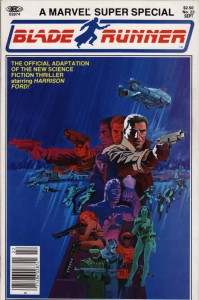
Kushner’s increasingly open these days to revealing the process behind his work to generate enthusiasm for the forms themselves and encourage others to experiment, as evinced by his recent contribution to TRIP CITY, a blow-by-blow narrative of the steps by which the first comic in the collection, “The Hall of Just Us”, called “Anatomy of a Photocomic”. The story, co-scripted by Emmy Award winning artist Dean Haspiel, led to its own formal photoshoot at the recently hurricane decimated by increasingly resilient Sunny’s Bar in Red Hook. Kushner and Haspiel set about “casting the roles, as we would for a film”, says Kushner, and the co-creators drafted full layouts for the comic before shooting, giving them a “map to follow”.
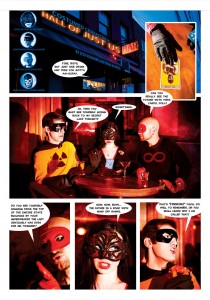
They created the comic shot for shot, a tale of three “miscreants”, superheroes in a bar chasing a super-powered lady’s attentions, “The Tarot”. After the shoot, time-consuming photo-shopping and comics construction added text, word balloons, and special effects. But all of this description only hints at the visual impact of “The Hall of Just Us”. It’s all about mood, created from strongly color-themed lighting (the pink, blue, and yellow of the cover’s design), and about the off-beat simple hero costumes straight off of Mego action figures or the BATMAN television show of the ‘60’s.
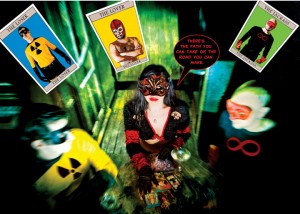
While the heroes posture and ratchet up the bombast, The Tarot figure, portrayed by model and artist Katelan Foisy, brings an eerie presence and substance to the narrative. She can see the future “sometimes” and sees the other heroes as Tarot figures, commenting “There’s the path you can take or the road you can make”, but she’s really calmly waiting for her “date” known as Señor Amore, portrayed by Haspiel. This is certainly the “romance” genre promised by the cover as one narrative alternative, but it leaves room for reader-interpretation. Superheroes with super powers are still hanging out in a bar, looking for love, for one thing.

“Spiders Everywhere” provides the “horror” also promised by the cover, and again homage to genre comics and films is evident. The narrative and premises are simple- horrific waves of spiders taking over the world, but Kushner plays to the strengths of the photocomix medium by conveying frantic movements and moments of psychological realization in cinematic style.
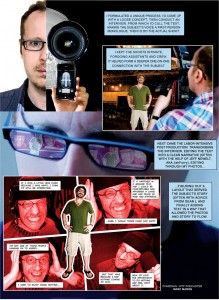
“Understanding Photocomix”, a visual walk through Kushner’s history with photography and photocomix, which first appeared in American Photo Magazine, supplies the metadata on the very form in which its composed. It also forms a clever narrative bridge between the first chapters of FORCEFIELD and its follow up chapter COMPLEX, by explaining Kushner’s increasing drive to push the boundaries of photocomix in a “full fictionalized graphic novel” that he’d “direct like a movie using actors and locations”. In many ways, FORCEFIELD is the herald of that process, and it’s Volume number “.01” suggests that it’s a forerunner of bigger things to come.

The story COMPLEX: “Luv_Underscores_U”, kicking off Kushner’s work on his dream project of the COMPLEX graphic novel, first appeared in Jimmy Palmiotti’s CREATOR OWNED HEROES #7 alongside Kushner and Irving’s ongoing profiles of indie comics creators (a follow-up project to LEAPING TALL BUILDINGS). It’s a lavishly shot and designed comic which plunges into science-fiction BLADE RUNNER style, another link to FORCEFIELD’s cover image. It constructs multiple virtual realities visually with ethereal attention to detail and emphasizes a governing psychological perspective, a central character keeping all these virtual worlds in motion for the reader. This isn’t far from the role of the camera itself seeming to direct the reader, perhaps FORCEFIELD’s hypothetical Super 8 on the cover itself.
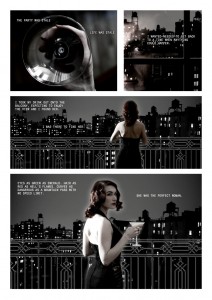
The final chapter of FORCEFIELD, a never before published noir tale, “The Perfect Woman” appears in uncharacteristic emphasis on black and white tones, with hints of color. Kushner’s photography is known for its psychedelic presentation of color through light effects, but also for his more sepulchral, moody hues in portraiture. Here he does with black what he often does with a solid color, making it a rich compositional basis into which he incises featured characters and settings. Like a compelling dime store novel rich with noir tropes, the story pursues an elusive lady in a cityscape from the visual perspective of a narrator. Kushner’s locations for this shoot were clearly exacting, capturing a city of the 1930’s complete with architectural detail. But the reader should have expected that this is a collection of stories with an expicit BLADE RUNNER homage and technology and perception may play as strong a role as the romance of pursuit.This is the “mystery” genre, completing the triad of color themes and pulp homage.

To add to the total design package that is FORCEFIELD FOTOCOMIX, it’s also presented in slick prestige magazine format with card covers, suggesting that photocomix can find their own effective dimensions for publication, in this case somewhere between a traditional comic and a traditional large-format photobook. But the format also speaks to Kushner’s consistent, passionate attention to detail throughout the collection which seems to constantly remind the reader of his fundamental belief in the art behind the form. The photocomix in FORCEFIELD are visually riveting, one might even say mind-altering, but the stories are also expansive, creating strange pocket universes with their own sets of rules and assumptions. Exploring them is part of the intrigue. Seeing FORCEFIELD in the wild is bound to make an impact on our assumptions about what photocomix have been, and more importantly, what they can be as a narrative medium in their own right. Kushner was inspired by comics, photography, and films to launch this project. In the future, creators might well be saying that they were inspired by FORCEFIELD to take photocomix in equally surprising and mesmerizing directions.

[Kushner answers, "What's the coolest item in your collection?" for Hanzarai.com]
FORCEFIELD FOTOCOMIX Vol.01 will be available for physical sale for the first time at the upcoming Asbury Park Comic Con March 30th, but the limited edition is already available for order through Kushner’s etsy shop.
Title: Seth Kushner’s FORCEFIELD FOTOCOMIX Vol.01/Publisher: Self-Published/Creative Team: Photographer, Seth Kushner/ Design, Seth Kushner and Dean Haspiel/ Writers, Seth Kushner, Dean Haspiel, Chris Miskiewicz/ Edits by Dean Haspiel
Hannah Means-Shannon writes and blogs about comics for TRIP CITY and Sequart.org and is currently working on books about Neil Gaiman and Alan Moore for Sequart. She is @hannahmenzies on Twitter and hannahmenziesblog on WordPress.
Earlier this week, Jimmy Palmiotti announced that the noble experiment CREATOR OWNED HEROES would conclude after its 8th issue. Over the course of the magazine’s publication, outreach on social media emphasized the need to raise awareness and increase solicitation from comic shops to keep the multi-contributor series in motion. Consistently strong reviews appeared on media, fan, and blog sites with each issue, and as COH developed, it continued to raise the bar on high-quality content. The ascent has been dizzying, and exhilarating for readers and comics creators alike in an era of increasing awareness about the ups and downs of self-publication. It has been like watching crucial surgery in a live operating theatre in the hands of celebrated practitioners where the audience has come to play an integral role. The life of the patient has depended on their rapt attention in increasing numbers. Depending on your perspective, issue #8 will represent the final bow of an effort exploratory and unique, or perhaps somber flat-lining during a risky procedure that practitioners will attempt to learn from for some time to come. But either way, COH won’t be concluding in obscurity. Ironically, there will be more people in the operating theatre than ever before to witness its final moments and draw their own conclusions.
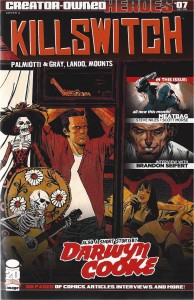
CREATOR OWNED HEROES #7 represents a particular crescendo in the magazine’s development, a point at which even those who have been following the series closely lean forward, aware that something unprecedented is unfolding before their eyes. It expresses a remarkable energy and a confluence of its methods and its goals due, in part, to the team of contributors it brings together. As Justin Gray says introducing his Brandon Seifert interview, “When we started Creator Owned Heroes, it wasn’t just a desire to self-publish; it was a multilevel dedication to comics that were being produced outside the work for hire landscape”. Gray also cites “ a fundamental desire to tell stories” as a common feature among the creators chosen as contributors. Issue #7 is a tour de force illustration of those criteria.
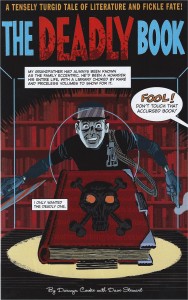
The powerhouse comic in the anthology is clearly Darwyn Cooke’s irreverent, rapidly paced and verbally exuberant “The Deadly Book”. Cooke hits high notes across the board of comic storytelling elements, from a lush, contrasty color palette in sky-blue, blood-red, and ink-black, to unexpected vantage points, compressed action, and even a very indie take on relating past events in short form via substantial narrative blocks. The comic displays the best possible outcomes for a skilled creator taken off the leash to tell the kind of story that they want to tell in the way that they see fit to tell it.
Jimmy Palmiotti, Justin Gray, Jerry Lando, and Paul Mountis follow Cooke with “Killswitch” in its 3rd installment of 4. They put the action back in indie in a big way and display a particular virtuosity in reversing a typical paradigm in espionage/hitman themed comics. Rather than telling the story with several panels, if not pages, of heavy exposition followed by the action sequences readers have been waiting for, they manage to reveal a wealth of exposition during an installment that, arguably, is one big action arc. They keep it interesting by demanding the reader put the pieces of information together for themselves, from Kill Switch’s complicated pseudo family life to the developing role of a nemesis. Rather than just telling a story well, which is a quite an achievement in itself, they manage to tell a story differently, once again illustrating the surprising results when creators have sufficient room for experimentation.
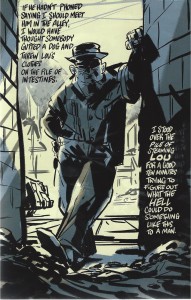
Steve Niles and Scott Morse bring an even greater variation in style and content to COH #7, pushing the boundaries of typical narrative structures while giving a nod to still-rich veins of comics tradition. They break down confined panel layout, and do away with textboxes and speech balloons to tell a noirish private-eye tale with disturbing gusto. “Meatbag’s” full page-feel conjures up Eisner’s SPIRIT while the first-person narrator places the storytelling firmly in Raymond Chandler territory. Add to these elements the use of limited color palette, heavy brush-stroke illustration and moody lettering, and you’ve got a finely balanced combination of old and new, making this a 21st century comic with a lot of room for innovation.
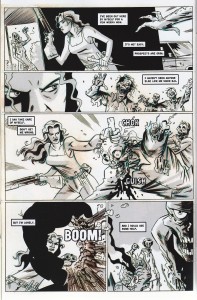
Then we have zombies. The subject-matter is in danger of being done into the ground in the TV, film, and comics medium, but in keeping with the challenges set by COH #7, Dean Haspiel and Jeffrey Burandt deliver something readers have simply never seen before, imploding any expectation of the familiar. Haspiel’s zombie artwork avoids the basic emphasis on blood and gore flooding zombie media these days and emphasizes, in a visceral way, the disjointedness of decomposition through trailing limbs and chunks of missing anatomy. This makes Haspiel and Burandt’s heroine seem all that much more solid, active, and vital as she spikes a zombie noggin and blasts through zombie brains. This is zombie-storytelling streamlined to basic psychological elements: loneliness, companionship, and, finally, the pulse-poundingly unexpected that makes the genre so popular. “Blood and Brains” retools zombie narrative by removing excess accretion and celebrating its potential in creator-owned style.
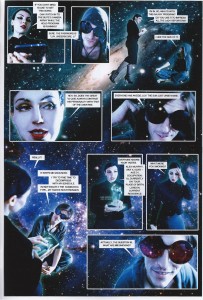
Photo-comic COMPLEX: “Luv_Underscore’s_U” by Seth Kushner, Chris Miskiewicz, and Dean Haspiel reminds us that the comics medium is expansive, varied, and should never feel too comfortable. Katelan Foisy and Miskiewicz star in this futuristic psychological landscape where the solid realities of the photo images help readers keep a grip on the otherwise shifting definitions of reality in the narrative. There’s a subtle ambiguity in the nature and future of technology, it’s use and misuse to contribute to human experience, and on the whole the photo-comic not only tells the reader but shows the reader the spell-like suspension of disbelief comics, in the right hands, are still capable of creating.
The prose content of COH #7 also contributes greatly to the purpose of the series, present from issue #1, of taking readers inside the world of creator-owned projects, an on the ground approach that not only educates but instructs. Justin Gray’s interview with Brandon Seifert allows the reader to hear straight from the horse’s mouth, “Want to be a writer? Start writing. It’s that simple, and that hard”. A “social media press conference” included in the issue also brings together advice and insight from creators and Steve Bunche concludes a full-on bootcamp for aspiring comics writers with plenty of solid advice that may seem counter-intuitive like “avoid topical subjects”. It’s clear that the meta-text of COH #7 is not there simply to sell books but to actually aid aspiring creators in avoiding the pitfalls that contributors have faced.

From issue #1, COH has given a strong impression of community among indie creators, and #7 continues to follow through in inclusiveness. A major profile of legendary tide-fighter Evan Dorkin, written by Christopher Irving, and photographed by Seth Kushner, only further illustrates the point. Creator-owned projects may seem like a new thing, maybe even a fad, but they aren’t. They’ve been breaking new ground for some time, and there’s plenty to be learned from observing the struggles of greats like Dorkin. Dorkin’s legacy in brief could be summed up in his statement: “I’ve come to hate when people say ‘Don’t get into comics’. I learned to say ‘Fuck that. If you want to get into comics, get into comics’”. But Dorkin, like many other creators, is also prepared to try to inform readers about what exactly they are getting into because a few tips a long the way can make all the difference.
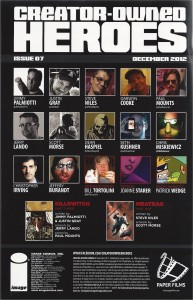
The combined tone and attitude of the comics and prose in CREATOR OWNED HEROES #7 avoids even the faintest whiff of defeatism. The series’ message is still going strong, and the works it presents don’t even aspire to meet the professionalism of company-owned comics, they aspire to go beyond company-owned projects in terms of high-quality story-telling, artwork and design. After all, what’s the point in trying to keep up with the Joneses when you really want to set a new standard all your own? As an experiment, the COH series is winding down, but the data is being collected, the procedure is nearly complete, and no one doubts the skill of the team involved. The increasing momentum generated in the pages of COH #7 has, certainly, guaranteed that no one will stop reading until the experiment is complete.
Hannah Means-Shannon writes and blogs about comics for TRIP CITY and Sequart.org and is currently working on books about Neil Gaiman and Alan Moore for Sequart. She is @hannahmenzies on Twitter and hannahmenziesblog on WordPress.
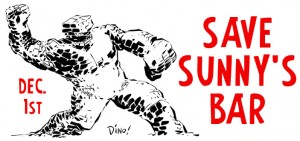
On Saturday, December 1st, the Hamilton Gallery Theater in Caroll Gardens, Brooklyn, hosted a benefit for a Red Hook landmark, Sunny’s Bar, in attempt to help bring it back from the verge of storm-ravaged closure. Sunny’s Bar, only a short distance from the waterfront, was filled with water and sludge by Hurricane Sandy, and its electrical systems, particularly, obliterated. The destruction of Sunny’s hit Brooklyn hard, a punch right in the heart of the artistic community specifically. For many, this was a retreat and a gathering place where memories were made for decades, and, thankfully, they weren’t prepared to let Sunny’s go down without a fight. Marketing, Public Relations, and Event Management professional Anica Archip , and her brother Dmitri Archip, spear-headed the benefit to complement the Sunny’s Kickstarter campaign, still underway, and provided the Hamilton event space. Local businesses donated refreshments, and a devoted arts community supplied over 5 hours of performance in honor of Sunny’s. Emmy-award winning comics artist and arts curator Dean Haspiel rounded up the talent and helped spread the word via social media while Sunny’s staff supported the event through set-up and bartending.
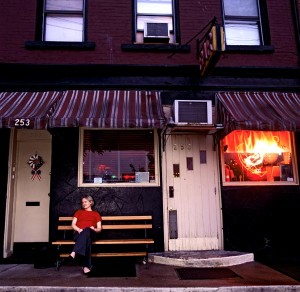
100% of the proceeds went to helping one of the most remote, and most beloved hangouts in Brooklyn back onto its feet. What started out as a small event elicited an overwhelming turnout to the point of rotating crowds off of the event floor to get as many people past the donations table as possible as performances ranged from readings of screen projected comics, poetry, and prose, to comedy performances, and lastly a few hours of wide-ranging musical sets by volunteers. The atmosphere was highly charged, emotional, but also celebratory throughout the night as community support for the benefit became more and more evident. In effect, it became a relocation of Sunny’s own events nights, a home away from home, prefiguring a return to its mecca status in days to come.

A number of the comics and prose performers hailed from Brooklyn’s own digital literary arts salon TRIP CITY, including co-curators Dean Haspiel, Seth Kushner, Chris Miskiewicz, and Jeffrey Burandt, joined by TRIP CITY member Jen Ferguson, and Brooklyn poet Denver Butson. Haspiel performed a comics meditation on Brooklyn and Manhattan during a time of crisis, Beef with Tomato, while also previewing a new creator-owned comic appropriately titled RED HOOK. Photographer and writer Kushner presented an event-inspired essay “My Brooklyn” with slides from his photo book Brooklynites, while writer Miskiewicz provided a haunting narrative set at the bar itself, “Last Night at Sunny’s”. Ferguson, an artist, narrated a CulturePOP photocomic featuring her own Brooklyn Bridge artwork, and writer and musician Burandt presented a recent Brooklyn-set comic “Bibbin’s Bodega” to the accompaniment of a mellow bass-line. Butson proved that poetry could hold its own as performance art with startling observations about the secret emotional and imaginative lives of ordinary citizens. The thematic pieces were well chosen, highlighting the role of community and geography as inspiration for creative work.
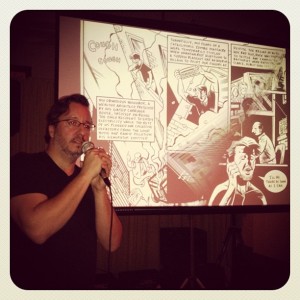
The comedy performances of the evening were raucous and added to the positive vibe building up during the benefit, turning the fund-raiser into an affirmation rather than a reflection on the devastating effects of the hurricane. Brooke Van Poppelen brought a Brooklyn perspective to the vagaries of working in Manhattan and commented on the increasing gentrification of Brooklyn itself, subtly asserting that enduring “real” Brooklyn culture continues in the face of change. Angry Bob came out from Queens to punch holes in the political climate of the recent elections and present the all-too human reactions to hurricane damage including outrage over cable outages in less affected areas. Meanwhile, donated beer on tap was flowing, along with wine, and the crowd situation on the floor was becoming intense. Between performance blocks rotation provided access to Sunny’s supporters.

The musical portion of the evening showcased an astonishing breadth of local talent, including the newly formed band Two Beards: One Heart with lead-singer Jeffrey Burandt debuting new material, John Pinamonti, The Black Coffee Blues Band, and Smokey Hormel supporting The Luna Sisters, many of whom perform as regular bands at Sunny’s on its own event nights. While blues music was particularly appropriate, The Luna Sisters, including Sunny’s proprietor Tone Johansen, really stole the show with their nostalgic and hypnotic performance of classics like “It’s a Wonderful World” and “Bye, Bye Blues”. “Yes, even after Sandy”, Tone declared, “it’s a wonderful world”. Proprietor Sunny himself too the mic to conclude the event, offering his heartfelt thanks and astonishment at the monumental support demonstrated for Sunny’s Bar. Appearing weathered, wearing waterproof clothes, he was nevertheless unbowed by the natural disaster that had struck at his life’s work. It was clear no one really wanted to go home, having missed gatherings at Sunny’s since the storm, but the owners vowed that next time the party would be “at home” when Sunny’s doors, aided by a big push from its denizens, opened again.

The evening came off without a hitch, and the funds raised were the best possible scenario for what started as an ambitious exercise in elbow grease. Anica Archip and Dean Haspiel agreed to tell me a little bit about what Sunny’s means to them and why they poured so much of their time and creativity into making the benefit happen. Archip and Haspiel, like many, have their own deeply personal memories of the beloved bar.
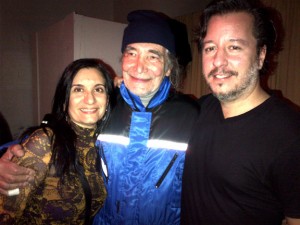
Anica Archip: I’m a Brooklyn, Cobble Hill/Carroll Gardens neighborhood native, Red Hook, Gowanus, and Brooklyn Heights was part of my playground. I remember the first time I set foot in Sunny’s Bar, it was a late summer afternoon around 1994. My car was towed from my street in Carroll Gardens and the lot where the city kept towed vehicles was located directly across the street from Sunny’s. My husband and I (I was married then ) were picking up the car and we were laughing over the whole incident because the day prior we were searching hours for the car convinced that we forgot where it was parked, versus the reality that it was towed. Anyway, as we exited the lot the door to Sunny’s Bar was open and we walked in for a drink. The bar was empty yet magical. The bright setting sun poured in through the window and once my eyes adjusted to the room, I realized we entered a realm frozen in time, a waterfront bar scene from the 1950′s. Behind the counter was a gentle faced man with long hair who looked like he stepped out of 1968, it was Sunny. We sat at the counter, told him of our car adventure and began to chat. I mentioned that my brother tends bar on Atlantic Ave, and just at that moment Sunny looked into my eyes, cupped my face with his large hands and said in his sweet tone, “I know who you are, you’re Dimitri’s sister.” Sunny’s Bar was instantly “home” – a place of comfort, where I could relax and I knew belonged. Needless to say I’ve been going back since.
In 1995 I became an active member of the Brooklyn arts organization BWAC (Brooklyn Waterfront Artists’ Coalition). Their yearly art show was held in the warehouses on the piers of Red Hook around the corner from Sunny’s. We would hang out at Sunny’s on Friday nights (the only night it was open back then) and listen to live music, it was impromptu not planned; talk with the neighborhood old timers; drink some Pabst or Schlitz beer, and just hang into the wee hours of the morning. You never arrived before 10pm, it became packed with artists, musicians, writers, dancers, and local neighbors by midnight and then closed about an hour or so before sunrise. And Sunny was always there to greet you with a big warm hug. Sunny’s hugs are special, just about everyone wants to be hugged by Sunny. It’s even listed as one of the items people can receive if they pledge a donation on the “Bring Sunny’s Back Home!” Kickstarter site:
Dean Haspiel: When I first moved to Brooklyn in 1997, I heard whispers about an old bar in Red Hook that hadn’t aged. When I first entered Sunny’s, it was like stepping into the past. An era I never lived in but always wanted to visit. And, it was one block away from the sea. It was the first bar I ever went to where the goblins in my head were quelled by the folk art and bluegrass music. I would just melt into the background for hours. It was a destination spot for people who wanted to get away and raise their glass to the Statue of Liberty and toast to an era of New York City that artists and blue collar workers could afford and pontificate a week of hard work.
Sunny himself would often appear like a specter of levity and brighten the room with his long hair and infectious smile. I got friendly with the bartenders and eventually met Tone, Sunny’s wife, who sings songs and curates the art shows in the back of the bar where musicians assemble and play music. I remember when Michael C. Maronna, star of the 1990′s kids TV show THE ADVENTURES OF PETE & PETE, would tend bar. Sunny’s is where my pal, Jonathan Ames, introduced me to actor/song writer, Jason Schwartzman, right before we started shooting HBO’s “Bored To Death.” In fact, a scene from “Bored To Death” was shot at Sunny’s. These days, I’ll occasionally bump into actor Michael Shannon and trade late night quips. But, more importantly, Sunny’s draws people who are worth their salt because it’s not easy to get to. Sunny’s is the last bar at the end of the world and when the apocalypse happens, that’s where you’ll find me.
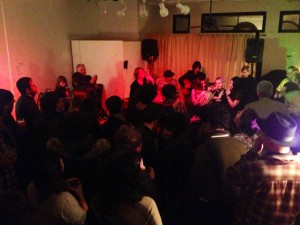
Haspiel and Archip also commented on the strange genesis of the idea for the event, which easily might have fallen by the wayside as Brooklyn, and the rest of the East Coast pushes to rebuild the essentials as quickly as possible.
AA: A small group (4 people + 1 cat) of Red Hook artist friends took refuge at my house when they had to evacuate due to the arrival of Hurricane Sandy. The morning after the superstorm hit we walked over to Red Hook to check out the damage and check in on other friends. What we saw was unexpected and shocking. My childhood friend’s home was severely damaged, people were coming out into the streets in tears, huge trees were ripped off their roots and power lines were left dangling. The streets were slicked with a coating of oil from boilers that were damaged and destroyed. The air was thick with the smells of oil and gas from spills that now settled in the streets of Red Hook. Block after block looked like aftermath of a war. I knew I had to check in on Sunny’s because they’re located at the very edge, just where the water meets the land. When I arrived Tone was standing outside with a look of horror in her eyes, tears started to flow from her face. We immediately embraced and she muttered, “Water is still rushing into the basement, the water is still coming in, I can’t stop the water.” A few people now gathered in front trying to help her and I overheard someone say that the water main pipe that connects to the building broke. They needed to shut off the city line from the sidewalk. An emergency vehicle, I think it was a utility company, pulled up in front of the bar and Tone ran to tell them of the problem. As I walked back home in silence my mind was racing with all I had witnessed and I felt helpless.
Dean & I had touched base in the days after Sandy and we briefly talked about what we saw and the damage to our beloved Sunny’s Bar. I then received an email from Dean about his idea to help Save Sunny’s, he asked if I was interested in helping and I knew that I could execute his vision. I immediately said Yes! And then approached my brother about having the benefit in our home.
A side bar note here is that Dean & I would occasionally meet up at Sunny’s throughout the years – we still do. In the early 2000′s after hangin’ at the Smith Street bars, on a Friday night, we’d sometimes do the Red Hook scene - which was Lilly’s Bar (now closed) and of course Sunny’s. You always ended the night at Sunny’s. Dean would ride over on his bike and I’d either walk it or take a car service. Attached is a b&w photo circa 2004(?) taken by my photographer friend Judy Parker (who was visiting from the Bay Area with her sister) of a Friday night walk along Beard street from Lillie’s to Sunny’s. Pictured is me, Dean’s bike and his cast shadow – sometime after 1am. I don’t think Dean’s ever seen this.
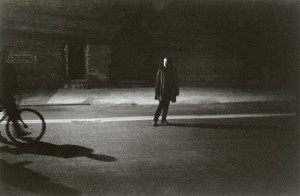
DH: A couple of days after Superstorm Sandy annihilated New Jersey and ravaged NYC, I rode my bike over to Red Hook and saw everyone’s destroyed basements on the sidewalks. When I finally got to Sunny’s, I saw the staff pumping water and made eyes with Tone. Sunny’s basement was a box of sludge, the boiler was busted and the electricity panels were destroyed among other flood damage to the bar. And, to make matters worse, the foundation was compromised. I knew right then and there that I had to do something. As Brooklyn began to rally relief, I made it my mission to help out the place I call home on the Friday and Saturday nights I unchain myself from my desk. I contacted my pal/publicist/event manager/and longtime friend of Sunny’s Bar, Anica Archip, to ask if she would manage and host an event [along with her brother Dimitri] to help promote and raise funds for Sunny’s. Anica immediately said “yes” and we approached Tone who said “yes,” offering to staff the night with the actual staff from Sunny’s. We co-curated the event and I designed a poster with Seth Kushner but it was Anica who truly handled all the nuts and bolts. Along with select TRIP CITY curators and contributors reading prose and comix (Jeffrey Burandt, Chris Miskiewicz, Jen Ferguson, Zees Moreno), local bands, poets, and comedians (Denver Butson, Brooke Van Poppelen, Angry Bob, Black Coffee Blues Band, Smokey & The Luna Sisters), we created a stellar evening that would bring people and diehard Sunny’s patrons together for a donation based evening where we provided entertainment and drinks. Jeffrey Burandt debuted his new band, Two Beards One Heart, and I debuted my new comic, The Red Hook. We gave them a little bit of Trip City to nosh on while recreating a night at Sunny’s. It was glorious.

Following the event, Archip and Haspiel reflected on the highlights of the evening that meant the most to them and made it all worthwhile.
AA: This one’s easy. Seeing the happy faces of Sunny’s clientele – his family of friends - my friends. A month had passed since Sandy hit and everyday in Red Hook has been devoted to the clean up. Pumping water, throwing out damaged personal items, family treasures, furniture, vital equipment, parts of your house, applying for help, filing papers. Sleep, rinse, repeat. But on this one night friends gathered, took a break, met up as they normally would at Sunny’s. They enjoyed the entertainment, had a beer or two, were greeted by a smiling, happy Tone, chatted with their favorite bartender and got their hug from Sunny. Helping to reunite this community of friends was worth it all.
DH: Besides witnessing all the support for Sunny’s, I think my favorite parts of the night were hearing Tone sing with her wonderful Luna Sisters and seeing Sunny end the evening with his gracious praise and infectious smile. He reminded us that this wasn’t for Sunny’s Bar but for us. All of us. Sunny’s Bar isn’t just another ancient watering hole. It’s an everlasting community.
Hannah Means-Shannon writes and blogs about comics for TRIP CITY and Sequart.org and is currently working on books about Neil Gaiman and Alan Moore for Sequart. She is @hannahmenzies on Twitter and hannahmenziesblog on WordPress.
































This looks great. Stunning actually, but at $10? Ouch. I realize the cost of making something like this is a lot, but at only 32 pages… It’s going to be a novelty item only till they can bring the price tag down. If this was $6, its a much easier buy.
[...] The Beat – Forcefield Fotocomix #.01 [...]